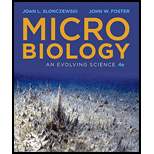
Concept explainers
To review:
The source and sink of electrons in respiration, lithotrophy, and photolysis.
Introduction:
An electron transport chain is a series of reactions in which the electron carrier transfers the electron to the carrier of the next- higher reduction potential (E) in a sequential manner. The electron flow is initiated with an initial electron donor from the outside of the cell that transfers the electrons to a terminal electron acceptor leaving the cell.
Explanation of Solution
Lithotrophy is an energy-yielding form of
In the process of photosynthesis, energy is derived from the photoexcitation of the light-absorbing pigment. The process of photolysis which is a light-driven separation of an electron from a molecule coupled to an electron transport chain is a consequence of photoexcitation. Photolysis is termed as “ light-reactions� that is coupled to “light-independent reactions� of carbon dioxide fixation in the plant chloroplast and cyanobacteria. The process of photoexcitation in ETS (electron transport system)-based photosynthesis causes the separation of the electron from a donor molecule like H2O (water) or H2S (hydrogen sulfide). The electrons are then transferred to an electron transport system which produces a proton potential and the reduced cofactor NADPH (nicotinamide adenine dinucleotide phosphate hydrogen). Proton potential is responsible to drive ATP (adenosine triphsophate) synthesis through an F1 and F0 ATP synthase.
Bacteria that are obligate aerobes grow only by using oxygen as the terminal electron acceptor like Sinorhizobiummeliloti. Although in anaerobic respiration, some bacteria and Archae use terminal electron acceptors like metals, oxidized ions of nitrogen and sulphur, and chlorinated organic molecules. In Escherichiacoli,different terminal oxidoreductases to reduce alternative electron acceptors are present which are termed as “reductases�. Some of the inorganic electron acceptors are nitrate (NO3) reduced to nitrite (NO2-) or NO2- reduced to NO (nitric oxide). The organic electron acceptors also play an important role in the process of food decomposition. In aerobic bacteria, the respiratory electron transport system leads to the formation of water by receiving electrons from NADH and FADH2 (flavin adenine dinucleotide dihydrogen) and transferring them to oxygen.
Want to see more full solutions like this?
Chapter 14 Solutions
Microbiology: An Evolving Science (Fourth Edition)
- please fill in the empty sports, thank you!arrow_forwardIn one paragraph show how atoms and they're structure are related to the structure of dna and proteins. Talk about what atoms are. what they're made of, why chemical bonding is important to DNA?arrow_forwardWhat are the structure and properties of atoms and chemical bonds (especially how they relate to DNA and proteins).arrow_forward
- The Sentinel Cell: Nature’s Answer to Cancer?arrow_forwardMolecular Biology Question You are working to characterize a novel protein in mice. Analysis shows that high levels of the primary transcript that codes for this protein are found in tissue from the brain, muscle, liver, and pancreas. However, an antibody that recognizes the C-terminal portion of the protein indicates that the protein is present in brain, muscle, and liver, but not in the pancreas. What is the most likely explanation for this result?arrow_forwardMolecular Biology Explain/discuss how “slow stop” and “quick/fast stop” mutants wereused to identify different protein involved in DNA replication in E. coli.arrow_forward
- Molecular Biology Question A gene that codes for a protein was removed from a eukaryotic cell and inserted into a prokaryotic cell. Although the gene was successfully transcribed and translated, it produced a different protein than it produced in the eukaryotic cell. What is the most likely explanation?arrow_forwardMolecular Biology LIST three characteristics of origins of replicationarrow_forwardMolecular Biology Question Please help. Thank you For E coli DNA polymerase III, give the structure and function of the b-clamp sub-complex. Describe how the structure of this sub-complex is important for it’s function.arrow_forward
 Concepts of BiologyBiologyISBN:9781938168116Author:Samantha Fowler, Rebecca Roush, James WisePublisher:OpenStax College
Concepts of BiologyBiologyISBN:9781938168116Author:Samantha Fowler, Rebecca Roush, James WisePublisher:OpenStax College
 Biology (MindTap Course List)BiologyISBN:9781337392938Author:Eldra Solomon, Charles Martin, Diana W. Martin, Linda R. BergPublisher:Cengage Learning
Biology (MindTap Course List)BiologyISBN:9781337392938Author:Eldra Solomon, Charles Martin, Diana W. Martin, Linda R. BergPublisher:Cengage Learning BiochemistryBiochemistryISBN:9781305577206Author:Reginald H. Garrett, Charles M. GrishamPublisher:Cengage Learning
BiochemistryBiochemistryISBN:9781305577206Author:Reginald H. Garrett, Charles M. GrishamPublisher:Cengage Learning Biology: The Dynamic Science (MindTap Course List)BiologyISBN:9781305389892Author:Peter J. Russell, Paul E. Hertz, Beverly McMillanPublisher:Cengage Learning
Biology: The Dynamic Science (MindTap Course List)BiologyISBN:9781305389892Author:Peter J. Russell, Paul E. Hertz, Beverly McMillanPublisher:Cengage Learning





